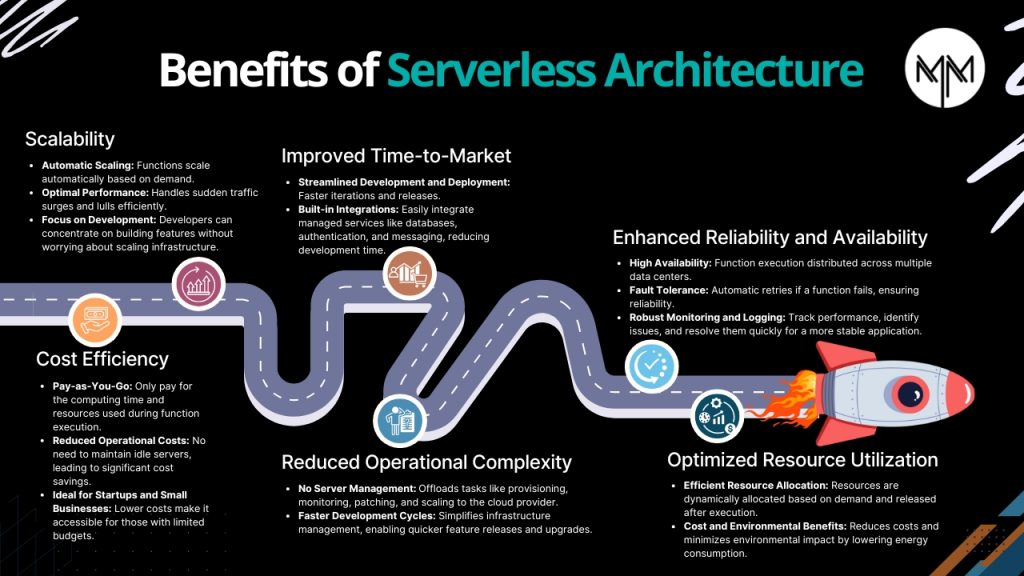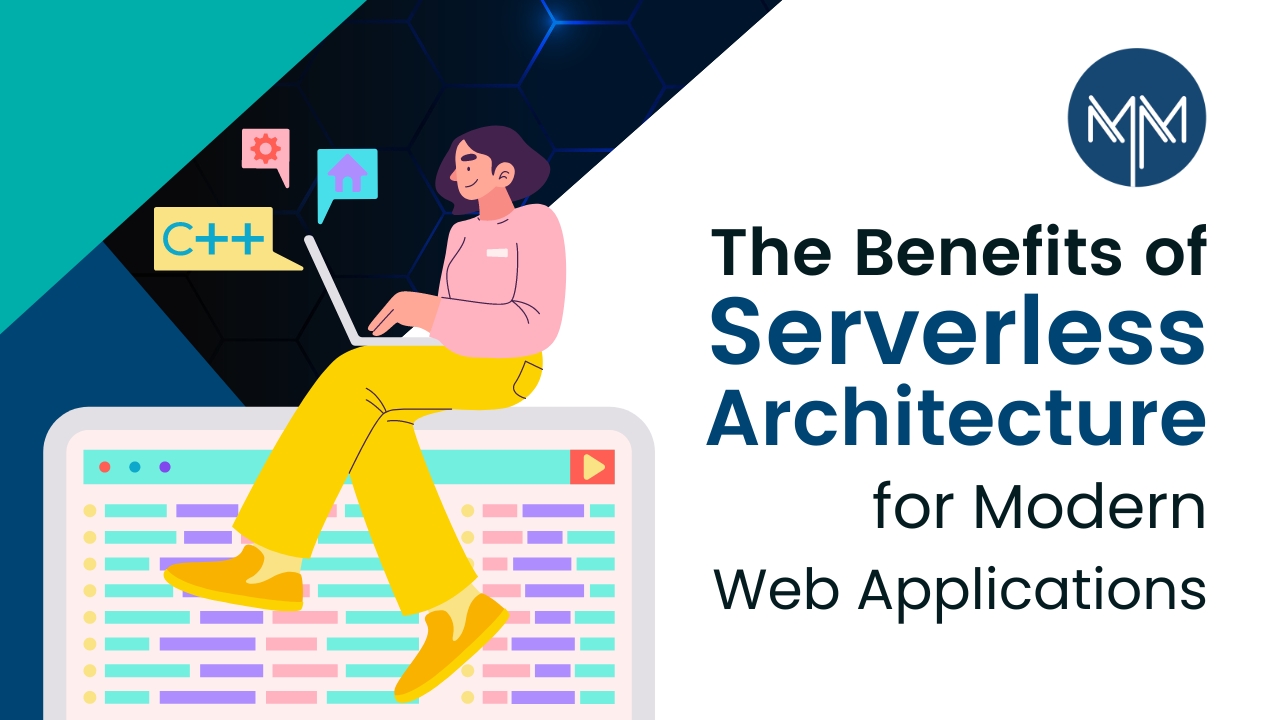The way we build web applications is undergoing a seismic shift. Traditional architectures, while reliable, can be like clunky spaceships: powerful but weighed down by the need for constant maintenance and fueling.
As companies strive for agility, scalability, and cost-efficiency, serverless solutions offer a compelling approach to building and deploying modern web applications.
Did you know?
The market for serverless apps is anticipated to expand at a compound annual growth rate (CAGR) of 23.4% from 2022 to 2032, reaching US$ 80,005.3 million.
This data indicates that serverless architecture is a revolutionary approach that’s streamlining development and propelling us toward a new era of web application creation.
We’ll dig into the fascinating domain of serverless in this blog and examine the many advantages it presents for contemporary online applications.
Serverless Architecture’s Benefits: Matrix Media’s Advantage
Serverless removes the burden of server management from developers’ shoulders. At Matrix, we have always believed in smart work, more than hard work.
Imagine no more wrestling with provisioning, configuration, and scaling servers. This newfound freedom allows our developers to focus on their core competency: crafting innovative features and functionalities. Here’s how serverless empowers our development team:
- Faster Development Cycles: Without server management overhead, we can move quicker, iterating on features and functionalities acceleratedly.
- Improved Developer Productivity: Freed from infrastructure concerns, our developers can dedicate more time to writing clean, maintainable code. This translates to a more efficient and productive development process.
Understanding the Basic
Before we explore the advantages, let’s clarify what serverless architecture entails. Contrary to its name, serverless does not mean the absence of servers. Instead, it refers to a model where developers are relieved of server management tasks.
In a serverless setup, applications are broken down into individual functions, which are executed in response to specific events. These functions, also known as Function as a Service (FaaS), run in stateless containers and are triggered by various events, such as HTTP requests, database changes, or file uploads.
Key Benefits of Serverless Architecture
- Cost Efficiency: One of the most significant advantages of serverless architecture is its cost efficiency. Traditional server-based models require maintaining idle servers to handle peak loads, resulting in underutilized resources and higher costs. In contrast, serverless platforms charge based on actual usage. You only pay for the computing time and resources consumed during the execution of your functions, leading to significant cost savings.
Additionally, serverless eliminates the need for provisioning and maintaining servers, reducing operational expenses. This pay-as-you-go model is particularly advantageous for startups and small businesses with limited budgets.
- Scalability: We believe scalability is critical for modern web applications, especially those with fluctuating traffic patterns. Serverless architecture excels in this regard, as it automatically scales functions based on demand. Whether you have a sudden surge in traffic or a lull, serverless platforms adjust the number of function instances to match the workload, ensuring optimal performance.
This automatic scaling not only enhances the user experience by maintaining consistent performance but also eliminates the need for manual intervention or complex scaling configurations. Developers can focus on building features rather than worrying about infrastructure scaling.
- Reduced Operational Complexity: Managing servers involves tasks such as provisioning, monitoring, patching, and scaling. These responsibilities can be time-consuming and require specialized expertise. Serverless architecture offloads these operational tasks to the cloud provider, freeing developers from infrastructure management.
Serverless allows development teams to focus on building and delivering code by abstracting away server maintenance. Due to this decrease in operational complexity, new features and upgrades may be released more quickly and development cycles are accelerated.
- Improved Time-to-Market: Serverless architecture accelerates time-to-market by streamlining the development and deployment process. With serverless, developers can quickly iterate and release new features without being bogged down by infrastructure concerns.
Moreover, serverless platforms often come with built-in integrations and managed services, such as databases, authentication, and messaging. These services can be easily integrated into applications, further reducing development time and effort.
- Enhanced Reliability and Availability: Serverless architecture inherently provides high availability and fault tolerance. Cloud providers distribute function execution across multiple data centers, ensuring redundancy and minimizing the risk of downtime. If a function fails, the platform automatically retries, enhancing reliability.
Additionally, serverless platforms offer robust monitoring and logging capabilities, allowing developers to track performance, identify issues, and quickly resolve them. This built-in reliability and observability contribute to a more stable and resilient application.
- Optimized Resource Utilization: Traditional server-based models often suffer from inefficient resource utilization, as servers need to be provisioned for peak loads, leaving them underutilized during off-peak times. Serverless architecture optimizes resource utilization by dynamically allocating resources based on demand.
With serverless, resources are allocated precisely when needed and released immediately after execution. This efficient use of resources not only reduces costs but also minimizes the environmental impact by lowering energy consumption.

Use Cases for Serverless Architecture
Serverless architecture is versatile and can be applied to various use cases, including:
- Web and Mobile Backends: Serverless is ideal for building scalable and responsive web and mobile backends. Functions can handle tasks such as API requests, user authentication, and data processing, ensuring seamless user experiences.
- Data Processing: Serverless functions excel at processing large volumes of data. They can be used for tasks like real-time data streaming, ETL (Extract, Transform, Load) processes, and batch processing, making them suitable for data-intensive applications.
- IoT Applications: Serverless architecture is well-suited for Internet of Things (IoT) applications. Functions can process and analyze data from IoT devices, trigger actions based on specific events, and scale effortlessly to accommodate varying loads.
- Microservices: Serverless aligns perfectly with microservices architecture. Each microservice can be implemented as a function, allowing for independent development, deployment, and scaling. This modular approach enhances flexibility and maintainability.
- Chatbots and Voice Assistants: Serverless functions are commonly used to build chatbots and voice assistants. They can handle natural language processing, integrate with third-party services, and respond to user queries in real-time.
Conclusion
The development and deployment of modern web apps have been completely transformed by serverless architecture. For developers and organizations, its cost-effectiveness, scalability, less operational complexity, and quicker time-to-market make it a desirable option. Although there are certain difficulties to take into account, serverless is a compelling solution for many different use cases since the advantages greatly exceed the disadvantages.
Future web development will probably be more and more influenced by serverless architecture as the cloud computing environment changes. Developers may achieve unprecedented levels of creativity and efficiency by adopting serverless, which will eventually improve user experiences and boost corporate performance.
The serverless revolution is here, and it’s poised to redefine the way we build web applications. Are you ready to join the movement?
Contact Matrix Media Solutions
Matrix Media Solutions understands your website and application needs. If you’re ready to build a serverless application that maximizes efficiency and scalability, our expert team is here to help. With cutting-edge technology and a client-focused approach, we ensure your project is a success. Don’t hesitate to reach out and transform your digital presence with us today. Contact Matrix Media Solutions now!


 October 25, 2024
October 25, 2024

